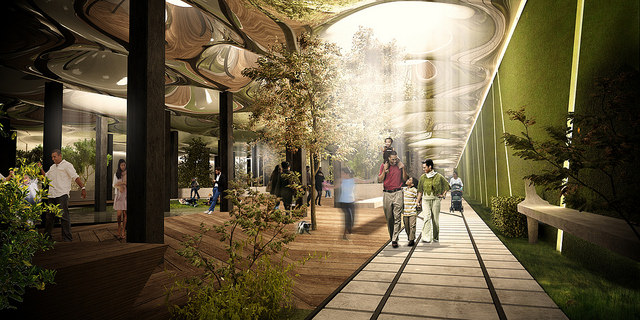Underground built environment

|
Anything that is located below the ground is regarded as being ‘underground’. Some of London’s mass transit system runs underground and is called the Underground.
The underground is a realm that contains a host of services – water and sewerage pipes, power and telecommunication cables, foundations and basements, as well as road and rail tunnels. Many tall buildings have numerous floors located underground. Creating and accessing these assets will usually require ground excavation.
Concerns about the disruption caused by the construction of basements, and the trend for ever larger 'iceberg' basements in cities such as London have resulted in attempts to introduce restrictions, such as the Basement Excavation (Restriction of Permitted Development) Bill and the Planning (Subterranean Development) Bill. For more information see: Basements.
Recent years have seen more attention being afforded to the exploitation of the underground realm as a means of relieving the congestion of city life. Some have argued that it is not just services, tunnels and basements that can be located underground, but also facilities that do not really need to be on the surface and can operate perfectly efficiently below ground. This can include waste treatment facilities, parking, factories, libraries, shopping malls, educational establishments, cinemas and theatres. Some have even argued for housing to be considered.
In New York, the Lowline (pictured) was a 16-month experiment which ran from October 2015 to February 2017 to gauge how green public space could be created and whether it could thrive underground. Using an acre of former industrial underground space that had been unused since 1948, the project funnelled daylight underground through a series of tubes; this allowed more than 100 plant and tree species to thrive and created a striking underground space. Having attracted over 100,000 visitors during its lifetime, the Lowline showed that parks could be created underground to provide space for relaxation and contemplation, away from the hustle and bustle of a modern metropolis.
[edit] Related articles on Designing Buildings
Featured articles and news
The UK's Modern Industrial Strategy: A 10 year plan
Previous consultation criticism, current key elements and general support with some persisting reservations.
Building Safety Regulator reforms
New roles, new staff and a new fast track service pave the way for a single construction regulator.
Architectural Technologist CPDs and Communications
CIAT CPD… and how you can do it!
Cooling centres and cool spaces
Managing extreme heat in cities by directing the public to places for heat stress relief and water sources.
Winter gardens: A brief history and warm variations
Extending the season with glass in different forms and terms.
Restoring Great Yarmouth's Winter Gardens
Transforming one of the least sustainable constructions imaginable.
Construction Skills Mission Board launch sector drive
Newly formed government and industry collaboration set strategy for recruiting an additional 100,000 construction workers a year.
New Architects Code comes into effect in September 2025
ARB Architects Code of Conduct and Practice available with ongoing consultation regarding guidance.
Welsh Skills Body (Medr) launches ambitious plan
The new skills body brings together funding and regulation of tertiary education and research for the devolved nation.
Paul Gandy FCIOB announced as next CIOB President
Former Tilbury Douglas CEO takes helm.
UK Infrastructure: A 10 Year Strategy. In brief with reactions
With the National Infrastructure and Service Transformation Authority (NISTA).
Ebenezer Howard: inventor of the garden city. Book review.
The Grenfell Tower fire, eight years on
A time to pause and reflect as Dubai tower block fire reported just before anniversary.
Airtightness Topic Guide BSRIA TG 27/2025
Explaining the basics of airtightness, what it is, why it's important, when it's required and how it's carried out.
Construction contract awards hit lowest point of 2025
Plummeting for second consecutive month, intensifying concerns for housing and infrastructure goals.
Understanding Mental Health in the Built Environment 2025
Examining the state of mental health in construction, shedding light on levels of stress, anxiety and depression.
The benefits of engaging with insulation manufacturers
When considering ground floor constructions.
Lighting Industry endorses Blueprint for Electrification
The Lighting Industry Association fully supports the ECA Blueprint as a timely, urgent call to action.























